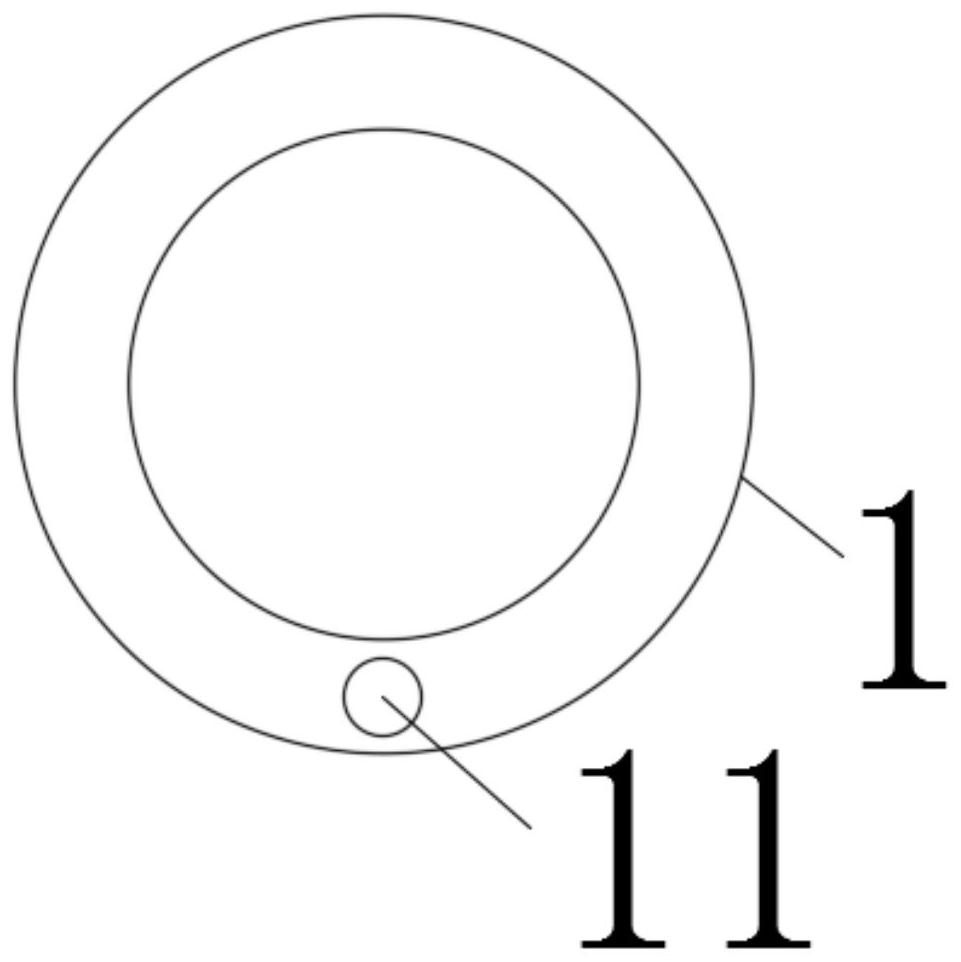Invasive blood pressure monitoring catheter capable of being exchanged quickly
An invasive blood pressure and catheter technology, applied in the direction of catheters, cardiac catheters, etc., can solve the problems of inconvenient repeated operations, poor hydrophilic effect of catheters, complicated operation, etc., and achieve the effect of preventing scratches on blood vessels and excellent hydrophilic performance
- Summary
- Abstract
- Description
- Claims
- Application Information
AI Technical Summary
Problems solved by technology
Method used
Image
Examples
Embodiment 1
[0049] Such as figure 1 with figure 2 Shown, a rapidly exchangeable invasive blood pressure monitoring catheter comprising:
[0050] Catheter body 1, the bottom of the catheter body 1 is provided with a guide wire channel 11, the bottom of the catheter body 1 is provided with a guide wire side hole 13 communicating with the guide wire channel 11, the top of the catheter body 1 A pressure measuring side hole 12 is provided, and the guide wire side hole 13 is nine to ten centimeters away from the left end of the catheter main body 1. The right end of the catheter main body 1 is integrally formed with a connecting pipe 14, and one side of the connecting pipe 14 A branch pipe 141 is installed through the control valve 142, the branch pipe 141, the connecting pipe 14 and the conduit main body 1 form a Y-shaped structure, and the inner wall of the connecting pipe 14 is provided with an internal thread;
[0051] A reinforcing rod core 2 is plugged into the inside of the catheter m...
Embodiment 2
[0064] The difference from Example 1 is that the outer wall of the catheter body 1 is provided with a hydrophilic coating, and the hydrophilic coating is prepared by the following method:
[0065] Take the following raw materials and weigh them by weight: 2 parts of chitosan, 2 parts of polyvinyl alcohol, 2 parts of polyacrylamide, 3 parts of polyacrylic acid, 2 parts of 2-methacryloyloxyethyltrimethylammonium chloride , 2 parts of polyethylene glycol dimethacrylate, 2 parts of water-based acrylic emulsion, 2 parts of sodium methyl silicate, 2 parts of butyl glycol ether, 10 parts of silicone defoamer, 20 parts of bentonite binder, 100 parts of deionized water;
[0066] S1. Prepare materials: first weigh the above raw materials;
[0067] S2. Primary mixing: first add deionized water into the digital constant temperature magnetic stirrer, then pour chitosan, polyvinyl alcohol, polyacrylamide, polyacrylic acid, 2-methacryloyloxyethyl trimethyl ammonium chloride, the stirrer ro...
Embodiment 3
[0075] The difference with embodiment 2 is the preparation of hydrophilic coating, and its specific preparation method is as follows:
[0076] Take the following raw materials and weigh them by weight: 6 parts of chitosan, 6 parts of polyvinyl alcohol, 6 parts of polyacrylamide, 7 parts of polyacrylic acid, 6 parts of 2-methacryloyloxyethyltrimethylammonium chloride , 6 parts of polyethylene glycol dimethacrylate, 6 parts of water-based acrylic emulsion, 6 parts of sodium methyl silicate, 7 parts of ethylene glycol butyl ether, 10 parts of silicone defoamer, 20 parts of bentonite binder, 100 parts of deionized water;
[0077] S1. Prepare materials: first weigh the above raw materials;
[0078] S2. Primary mixing: first add deionized water into the digital constant temperature magnetic stirrer, then pour chitosan, polyvinyl alcohol, polyacrylamide, polyacrylic acid, 2-methacryloyloxyethyl trimethyl ammonium chloride, the stirrer rotating speed was at 135r / min, and the tempera...
PUM
 Login to View More
Login to View More Abstract
Description
Claims
Application Information
 Login to View More
Login to View More - R&D
- Intellectual Property
- Life Sciences
- Materials
- Tech Scout
- Unparalleled Data Quality
- Higher Quality Content
- 60% Fewer Hallucinations
Browse by: Latest US Patents, China's latest patents, Technical Efficacy Thesaurus, Application Domain, Technology Topic, Popular Technical Reports.
© 2025 PatSnap. All rights reserved.Legal|Privacy policy|Modern Slavery Act Transparency Statement|Sitemap|About US| Contact US: help@patsnap.com


